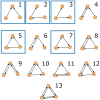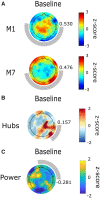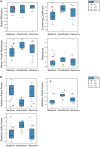Brain network motif topography may predict emergence from disorders of consciousness: a case series
- PMID: 33376599
- PMCID: PMC7751128
- DOI: 10.1093/nc/niaa017
Brain network motif topography may predict emergence from disorders of consciousness: a case series
Abstract
Neuroimaging methods have improved the accuracy of diagnosis in patients with disorders of consciousness (DOC), but novel, clinically translatable methods for prognosticating this population are still needed. In this case series, we explored the association between topographic and global brain network properties and prognosis in patients with DOC. We recorded high-density electroencephalograms in three patients with acute or chronic DOC, two of whom also underwent an anesthetic protocol. In these two cases, we compared functional network motifs, network hubs and power topography (i.e. topographic network properties), as well as relative power and graph theoretical measures (i.e. global network properties), at baseline, during exposure to anesthesia and after recovery from anesthesia. We also compared these properties to a group of healthy, conscious controls. At baseline, the topographic distribution of nodes participating in alpha motifs resembled conscious controls in patients who later recovered consciousness and high relative power in the delta band was associated with a negative outcome. Strikingly, the reorganization of network motifs, network hubs and power topography under anesthesia followed by their return to a baseline patterns upon recovery from anesthesia, was associated with recovery of consciousness. Our findings suggest that topographic network properties measured at the single-electrode level might provide more prognostic information than global network properties that are averaged across the brain network. In addition, we propose that the brain network's capacity to reorganize in response to a perturbation is a precursor to the recovery of consciousness in DOC patients.
Keywords: anesthesia; brain networks; disorders of consciousness; electroencephalography; graph theory; network hubs; network motifs.
© The Author(s) 2020. Published by Oxford University Press.
Figures






References
-
- Bagnato S, Boccagni C, Prestandrea C, et al. Changes in standard electroencephalograms parallel consciousness improvements in patients with unresponsive wakefulness syndrome. Arch Phys Med Rehab 2017;98:665–72. - PubMed
-
- Bai Y, Xia X, Wang Y, et al. Electroencephalography quadratic phase self-coupling correlates with consciousness states and restoration in patients with disorders of consciousness. Clin Neurophysiol 2019;130:1235–42. - PubMed
-
- Casali AG, Gosseries O, Rosanova M, et al. A theoretically based index of consciousness independent of sensory processing and behavior. Sci Transl Med 2013;5:198ra105. - PubMed
LinkOut - more resources
Full Text Sources
